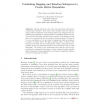Free Online Productivity Tools
i2Speak
i2Symbol
i2OCR
iTex2Img
iWeb2Print
iWeb2Shot
i2Type
iPdf2Split
iPdf2Merge
i2Bopomofo
i2Arabic
i2Style
i2Image
i2PDF
iLatex2Rtf
Sci2ools
IDA
2007
Springer
2007
Springer
Combining Bagging and Random Subspaces to Create Better Ensembles
Random forests are one of the best performing methods for constructing ensembles. They derive their strength from two aspects: using random subsamples of the training data (as in bagging) and randomizing the algorithm for learning base-level classifiers (decision trees). The base-level algorithm randomly selects a subset of the features at each step of tree construction and chooses the best among these. We propose to use a combination of concepts used in bagging and random subspaces to achieve a similar effect. The latter randomly select a subset of the features at the start and use a deterministic version of the base-level algorithm (and is thus somewhat similar to the randomized version of the algorithm). The results of our experiments show that the proposed approach has a comparable performance to that of random forests, with the added advantage of being applicable to any base-level algorithm without the need to randomize the latter.
Related Content
| Added | 08 Jun 2010 |
| Updated | 08 Jun 2010 |
| Type | Conference |
| Year | 2007 |
| Where | IDA |
| Authors | Pance Panov, Saso Dzeroski |
Comments (0)

